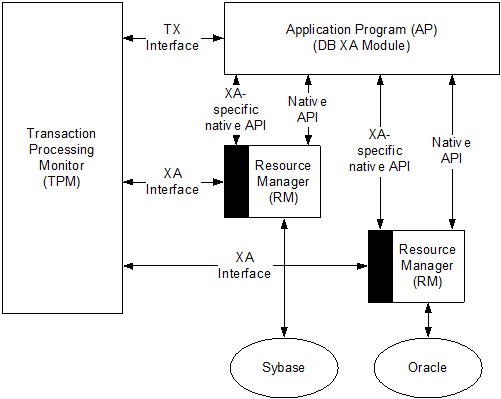Overview
The Abstract X/Open DTP Model
This chapter provides a brief introduction to transaction processing in an XA-compliant environment, then describes the role that the DB XA Module plays in that environment. Here are definitions of some of the terms used in this chapter:
Figure 1 illustrates where the DB XA Module fits in an X/Open DTP environment. As shown in the figure, the X/Open DTP model consists of three main parts:
Figure 1 – An abstract model of the DTP environment.

A path of communication between any two parts of the X/Open DTP Model is called an interface. As shown in Figure 1, the DTP model has the following interfaces:
The AP-RM interface allows an application program to call a resource manager directly, using the RM’s native API, when the transaction does not need to be managed by the TPM. The AP-RM interface allows the AP to perform database connection management, transaction management, and database manipulation.
When the requested transaction must be managed by a TPM through the XA interface, however, the TPM becomes responsible for managing the database connections and transactions. To perform database manipulations under these circumstances, the AP requires the connection handles of the connections opened by TPM. The AP uses an XA-specific native API to fetch the database connection handles, and then uses these connection handles for data manipulation through the native API.
This is also known as the TX interface. It lets the application program call the transaction monitor to request transaction management. X/Open defines an API for starting and ending transactions, directing the completion of a transaction, and obtaining status information about transactions. This interface must be supported by all X/Open-compliant TPMs.
This is also known as an XA interface. It allows two-way communication between the transaction monitor and the resource manager, and implements the two-phase commit between them. As an XA interface, it provides the standard set of routines described in the XA specification. The transaction monitor uses these routines to manage global transactions.





